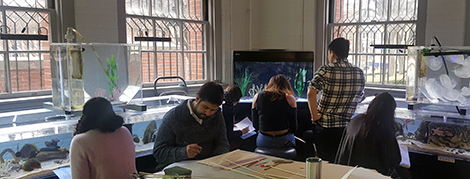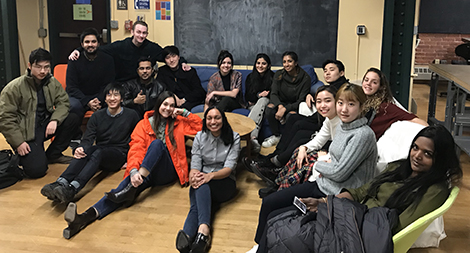UA BRINGS BIOMIMICRY TO STUDENTS AT RHODE ISLAND SCHOOL OF DESIGN
Biomimicry – the emulation of biological forms, processes, patterns and systems to solve technical challenges – was the subject of a five-week course taught earlier this year at the Rhode Island School of Design by Dr. Emily Kennedy, the director of external relations at our Biomimicry Research and Innovation Center (BRIC).
Kennedy and guest lecturers – including BRIC faculty members Dr. Henry Astley and Dr. Petra Gruber, experts in the fields of biomechanics and biodesign, respectively – delivered the three-credit course, “Intro to Biomimicry,” to students from RISD and Brown University.
The course was spearheaded by Peter Lawrence, president of Biomimicry New England, a nonprofit organization dedicated to biomimicry education, and Charlie Cannon, the head of the Industrial Design Department at RISD.

The students – representing disciplines ranging from apparel and graphic design to film, architecture and biochemistry – gathered in RISD’s Nature Lab to observe, draw and model biological specimens, as seen in the photo above, with the help of RISD faculty members Jorge Paricio and Tom Weis.
At the end of the course, groups of students applied biological principles to a conceptual design project of their choosing. One group considered how white beetle wing scale reflectivity could inspire energy-efficient lighting. Other groups investigated how the howler monkey’s air sac might be mimicked in a non-electric amp for musical instruments, and how the heat-tolerant Pompeii worm could inform the design of firefighting gear.
“The beauty of the method I learned in this class was in finding an unlikely solution in nature through a process I never knew existed before,” says McKenzie Everett, an RISD undergraduate studying apparel design, pictured below with classmates and Dr. Emily Kennedy, seated in the center in front of the blackboard.

Dr. Peter Niewiarowski, professor of biology here at UA and one of BRIC’s principal investigators, says he looks forward to future collaboration with RISD and Biomimicry New England.
“BRIC was ecstatic that it could help support Dr. Kennedy’s successful teaching of the class with partners from RISD and Biomimicry New England,” Niewiarowski says. “Such collaboration sets the stage for the possibility of deeper interactions in teaching and research, which would be extraordinarily valuable.”
Source: University of Akron Digest
